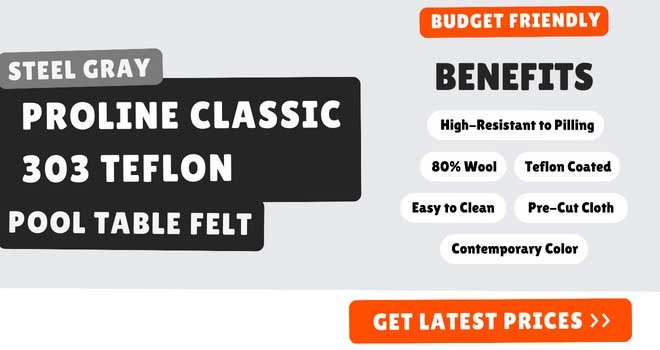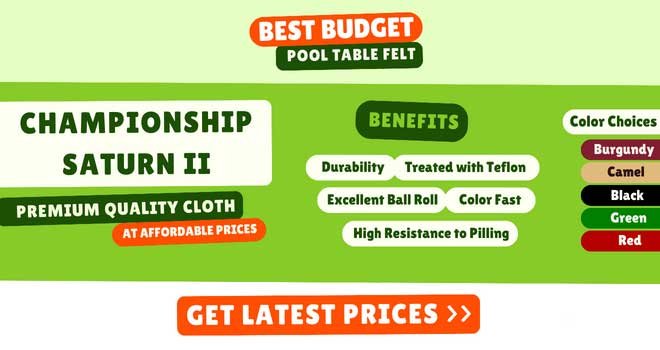Can You Change the Color of Pool Table Felt? The Best Method

When it comes to enhancing the aesthetics of your game room, one of the most impactful changes you can make is with the playing cloth color.
In particular, changing the color of the pool table’s felt can make a massive difference.
Not only does this provide a fresh look, but it can also influence the ambiance of the room and even the gameplay experience.
The good news is, yes, you can change the color of pool table felt, however the color you change it to has a significant effect on gameplay experiences.
The best colors of playing cloth are green and blue in terms of playability, however that’s not to say that suits every player and there’s a lot that goes into the decision making process.
Key Takeaways
- Changing the felt color is not just about aesthetics; it can also impact the visibility of the balls.
- Choosing the right felt color can enhance the ambiance of your game room.
- Room lighting plays a pivotal role in how the color of the pool table felt is perceived.
Why Change the Pool Table Felt Color?
Visibility and Gameplay
One of the primary reasons players opt to change their pool table felt color is to improve visibility.
- Science plays a bigger role than ever within most sports today, and studies behind the effect of colors heavily influence how they are used.
- According to the science, traditional green felts, while classic, might not offer the best contrast for all ball colors.
Switching to a color like Tournament Blue, for instance, provides optimal visibility of the balls, especially in rooms with specific lighting conditions.
Aesthetic Appeal
Beyond gameplay, the color of your pool table felt can be a significant design element in your game room.
Modern homeowners are experimenting with vibrant felt colors like orange, red, and purple.
Though not the best for gameplay, bright colors can stand out and completely transform the mood of a room.
These colors not only make a statement but also allow homeowners to align the look of their pool table with the overall design theme of their space.
Personalization
Your pool table is an extension of your personality. By choosing a unique felt color, you can make your table stand out and showcase your personal style.
Whether you prefer a sleek black-felt table or a vibrant red one, the options are endless.
Customized pool table felt is becoming increasingly popular and is a great way to reflect your personality, game room theme, football team or even your business.
Dark vs Light Pool Table Felts? Pros and Cons

Dark Pool Table Felts Pros
Aesthetic Appeal
Dark felts, especially colors like deep green can give a pool table the classic look.
Dark colors like for instance black and grays create a modern looking aesthetic and sophisticated style, especially when combined with a modern interior with a darker color paletter
They can easily blend with a room’s decor, especially if the room has a darker color palette.
Warm Atmosphere
Colors like burgundy, can help create a warm and homely atmosphere when paired with rustic, wood interiors.
Dark Pool Table Felts Cons
Dark Shadows
One of the main challenges with dark felts is that they can create visibility issues during gameplay.
- The 8-ball, for instance, can almost disappear against a black felt, making shots more challenging.
- Pronounced shadows, and the pocket edges can also disappear on black felt, especially if the room’s lighting isn’t quite right.
This can make it difficult to see pocket edges or judge angles accurately.
Dust and Dirt
Though darker felts like black for instance wont show certain stains as much, dust attracts to black and shows up every particle that lands on the table, which means more maintenance unless you use a pool table cover.
Light Pool Table Felts Pros
Gameplay
Light-colored pool table felts, such as tournament blue and classic green are the best colors of playing cloth for gameplay.
These colors produce the best color contrast between balls and cloth, is more pronounced, making it easier to plan and execute shots.
Player Moods
Bright colors like for instance yellow, have strong connotations to positivity and happiness which can help to boost the moods of players.
Light Pool Table Felts Cons
Stain Visibility
Light felt colors will hide less dirt, particularly stains, chalk marks, and other debris much less than darker playing cloths.
Maintenance is important regardless of the type of felt or color, however your routine will need to be that slight bit better.
Reflecting Light
Light bounces and reflects off bright colors, whereas darker felts absorb more.
Playing on bright colors like red or yellow can be a problem during long sessions, which can cause headaches and eye fatigue among players.
The lighting is important and a bright playing cloth doesnt need too much lighting or becomes too distracting for our eyes to process.
How Can You Change the Color of Pool Table Felt?
The most common way of changing the color of pool table felt is by replacing it with a new one.
Which in truth is probably the best, and easiest option for most people, if they want a change of color and the cloth is worn out.
To change the color of your current playing cloth, there are two DIY options which include:
Word of caution:
Doing it yourself doesn’t always produce the best results for the playability of the cloth, however, if it is a project, that’s a different story and can create a fun experience to experiment with colors.
You can also put a logo on your pool table felt, which I have a whole article on, to give it that extra wow factor.
Understanding Grades of Pool Table Felt
When considering a change in felt color, it’s essential to understand the different grades of pool table felt available.
The quality of the felt can influence ball movement, spin, and overall gameplay experience.
Standard Grade Felt
- Material: Felted Wool
- Characteristics: Slight nap or fuzz on the surface
- Ball Movement: Balls travel the slowest on this grade
- Durability: Moderate
Standard Grade felt is ideal for casual players and those on a budget.
Championship Saturn
Championship Saturn II pool table felt is great budget friendly playing cloth, availaible in wide range of colors, that plays to premium quality.
Championship is a trusted brand offering a variety of felts that cater to different needs and budgets, including their Tour Edition, Invitational with Teflon, and Valley Teflon Ultra lines.
Premium/professional Grade Felt
- Material: High-Endurance Worsted Wool
- Characteristics: Uniform, woven surface texture with a protective coating
- Ball Movement: Faster than Standard Grade
- Durability: Very High
Premium Grade felts are designed for serious players who want a superior playing experience that offers professional quality.
It offers the fastest ball travel and is built to last, making it a worthy investment for avid players.
Simonis 860
Simonis pool table cloth is considered professional-grade felt the two most popular colors are green and blue.
Simonis is globally regarded as one of the best pool fabrics available and is often used in professional pool tournaments and by serious players who seek the highest quality playing surface.
There premium playing cloth, such as Simonis 860, are known for their superior durability, consistency, and accuracy, which are essential qualities for professional-level play.
Historically, green has always been the most popular choice for pool table felts.
In recent times, tournament blue, driven by science, has gained popularity, especially in major pool tournaments.
Both colors are considered to be the best colors of pool table felt and the least straining on the eyes, providing a fresh contrast against the colored and white balls, making them stand out more.
Tips Changing the Color
Avoid Black and Bright Colors if Serious About Your Game
While a black felt on a pool table is sleek and stylish, it’s not the best choice for gameplay.
If you are serious about your game, you may want to avoid it, and here’s why:
- The darker felt creates pronounced shadows.
- The 8-ball tends to blend with the felt, making it less visible.
- Pockets become obscured due to the dark shadows, complicating shots.
Bright colors like yellow and red can be too much information for our eyes to digest.
Overly bright colors reflect light and which bounces back into players eyes and during long sessions can take their toll causing headaches among some players.
Consider the Decor of the Room
For most of us, being comfortable in our surroundings and having a pool table that compliments the decor can be a big factor in the decision of felt color.
If you play a lot, the performance of the felt should take precedence.
For most casual players, playability may pale in comparison compared to choosing a color that compliments the room’s decor.
If that’s the case, your personal preference matters, so don’t settle for a color you dislike just because it matches the room.
Visit a Showroom to Clear Up Confusion
If you are not sure about the color, visiting a showroom is a great option for clarity.
- A showroom allows you to handle and view samples of different felts in various colors.
- You can see how they appear under different lighting conditions and against various table styles.
This hands-on experience can give you a clearer idea of how the felt will look in your space.
Different Colors Need Different Lighting
Room lighting plays a crucial role in how the color of pool table felt is perceived.
Bright lighting can intensify the felt’s color, making it appear more vibrant, while dim lighting can mute the color, making it look darker than it actually is.
The type of lighting (e.g., warm vs. cool) can alter the color’s hue, for instance:
- Warm lighting might make a green felt appear more yellowish.
- Cool lighting could give it a bluish tint.
Proper lighting ensures that players can see the balls clearly against the felt, aiding in gameplay.
Inadequate lighting, combined with a poorly chosen felt color, can lead to visibility issues and hinder the playing experience.
References
https://www.ritdye.com/faq/can-i-dye-felt-for-a-pool-table/
https://www.impactplus.com/blog/the-psychology-of-design-the-color-blue-in-marketing-branding
https://www.frontiersin.org/articles/10.3389/fpsyg.2018.00045/full











